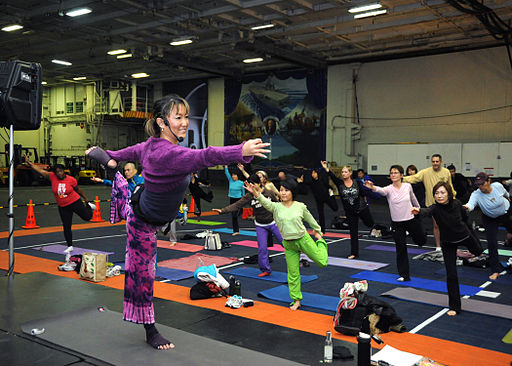“I need your feet to be exactly 3.5 feet away from each other.”
As she shouted these words into her Madonna-like wireless microphone, the instructor simultaneously glared and pointed at me from across the room, “That’s right, you in the pink pants!” no doubt, just to drill it in and make certain that I—and everybody else—knew that I was indeed the one getting the demerit.
I’ve been teaching yoga since 2002 when I received my initial certification in NY. I’ve since taught and studied many styles all over the country, and have encountered a vast array of challenges along the way (both as instructor and practitioner), all of which I’d like to think I’ve learned from.
I’m now traveling with a touring production of Dirty Dancing—The Classic Story On Stage (yes, as in “Nobody Puts Baby in a Corner”), and taking and teaching yoga across North America. I have not been home in six months. The only constant in my life is change and that includes new instructors and studios every one to two weeks.
I’m always the new kid—at least while I am on this tour.
A few months ago, I found myself taking a much too hot power yoga class in Houston. The room was packed with an aggressive, post-work crowd mat to mat, sardine style. The space was mirrored and one wall doubled as a huge chalkboard emblazoned with scribbles about upcoming events.
Detox! Change your life! Juice cleanse! Challenge!
There were all sorts of things that begged the question “How do I fix what is so obviously wrong with me?”
The temperature was way over 110 degrees, the music was cranked up ridiculously loud, and the teacher seemed to be completely agitated by everyone in the room. She did, however, repeatedly dote upon her favorites: “Great job, Jeff.” “Lookin’ good in that tank top tonight, Marie!” As I looked around the room, I noticed that not a soul was smiling, and that in fact, everyone looked absolutely miserable, including Jeff and Marie.
As the sweat poured off of me, she walked right up to my mat, knelt down and repeated her request with great specificity. “Exactly 3.5 feet apart!” I made eye contact and quietly let her know that I was all set and working around an injury. It was my first time at this studio. Nobody knew anything about my practice, my body, or my needs that particular evening. I was at once pissed off and a little scared of her.
“Whatever!” I am not kidding, that was the word (spoken in true teen angst style) which she then uttered into the surround sound system. I was shocked that someone labeled as a Yoga instructor could act like that. She moved on to target someone across the room who must have had their namaste hands 1.5 inches too close, and I went into child’s pose to gather myself. I made it through a few more poses, then quietly slipped out of the room once she put the group into down dog.
I tried a class in D.C. that was labeled with a revered yoga legend’s name. I walked over to the teacher, introduced myself and took a seat. She immediately called out, “In these classes, we face our mats towards one another like so”. The room was divided into two groups facing each other, with her mat placed in the center. Class began and it was all downhill from there.
The first request was that we make animal sounds, and loudly to boot. I noticed that no one else had an issue with this request, and that they must have all been regulars. One guy kept randomly hopping up and assisting a woman one mat over. There was constant banter between both the instructor and the attendees about things going on outside the studio including someone’s art opening, a shoe store sale, and a farmers market. I stayed until class ended only to see that we had gone fifteen minutes over without any mention of it. I was late to my next appointment and frazzled.
In Massachusetts, I dropped into an “active flow” class. It was clearly mislabeled because what was being taught was a gentle, restorative sequence. At the time, I was a diehard Ashtanga practitioner and was used to a very specific breathing technique. I adapted to the easygoing class and got over the fact that I wasn’t going to get my active class.
This instructor stood right at my mat’s edge for most of the session, sternly announcing things like “in this class, we do not use the old fashioned breathing techniques from India,” and “there’s no need to breathe noisily in this class.” What I noticed most was that she was perturbed, and that the repetition of what she needed me to do seemed more about her being annoyed than any particular style of pranayama (breath work).
At one point I couldn’t hear what she was cueing so when she walked passed I quietly asked if she could please turn the music down a bit. “I’m in charge of the stereo here!” she snapped, then stomped away.
Yes, sadly, this really happened.
What can we learn from the experiences I’ve shared here? While I think that we can all agree that everyone has an off day teaching here and there, care must be taken upon entering the studio to teach. Instructors are obtaining certifications and going out into the world ready to teach asanas, yes; but are they ready to present classes with presence, patience and compassion?
Some takeaways from from less than perfect classes:
1. One yoga does not fit all.
It is an honor and a privilege to share yoga with anyone who is willing to trust you with their time, money and health. Be willing to study and teach to attendees of all levels. Even if you have trained to teach a very strict style of yoga, be ready to bend, to evolve and let your classes become more organic. Some of the best advice I was ever given about teaching was “teach to who is in the room.”
2. Keep the cliques out of the studio.
While it’s fantastic to engage socially via your yoga studio, getting involved in the community and branching out, teachers need to be mindful of cliques forming in the classroom. I’m also leery of any teacher training where they instill the need for one to constantly call out students by name during class (whether it be for compliments or reprimands). All inclusive is the way to go; all are welcome, every day. It’s always nice to throw in a genuine “great work, everyone,” at the end of a challenging class.
3. Always, always introduce yourself and make eye contact with any first time attendees.
Ask about any injuries, questions or concerns that they may have prior to starting your class. Check in halfway through the session and quietly ask how they are doing. Singling out people who are struggling or thriving is a surefire way to alienate others in the room as well. Try to recall your first yoga class and do what helped you have a good experience. If you didn’t have a positive experience with your first class, be as supportive as you wish your instructor had been.
4. Communicate.
If someone looks like they are going to hurt themselves, whisper a gentle, helpful suggestion. There’s no need to shame a yogi into modifications or taking a break. People trust you and need you to be present and attentive. Thank everyone for attending at the end of class and never take for granted that they have taken time to practice with you.
5. If you’re using music, make sure that your voice can clearly be heard, even in the back of the room.
Try to think of it as white noise that will enhance, not take away, from your teaching. Once a week let a student make up a playlist so that you keep the music fun and fresh while bringing everyone into the fold.
6. Use a watch!
Keep a close eye on the time and do not go over. If you have to go over even a few minutes, make an announcement right before Savasana so people may leave if they need to. My clients have often communicated that they arranged for a sitter just so they could get out to take a class. Be mindful that this may be their only “me” time for the entire day, and that they have places to be, on time.
I look forward to sharing more tales of yoga on the road. I’m certain that there will always be a mixed bag of great and not so great yoga experiences out here. Until next time, get out there and take a chance on a new class every now and then.
I believe that we can learn from every teacher, from every class, even the “scary” ones!
Relephant:
Things Your Yoga Teacher is Dying to Tell You (But Probably Won’t).
Author: Anna Maria Giambanco
Editor: Renée Picard
Photo: Wiki Commons












Read 3 comments and reply